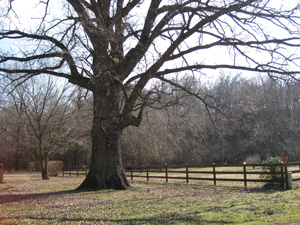Resource Library
Plant of the Week: Trees in Drought
The University of Arkansas System Division of Agriculture does not promote, support or recommend plants featured in "Plant of the Week." Please consult your local Extension office for plants suitable for your region.
Plant of the Week
Trees in drought

At every turn we are seeing and hearing about how the drought of 2012 is causing economic distress by devastating crop yields, threatening forest fires and generally wreaking havoc in every quarter. Arkansas, if you look at the latest drought map, seems to be the epicenter of this monstrous event that now affects most of the country and grows more severe with each passing day. While most of us don’t have crops or livestock to worry about, we do have trees to consider.
Unfortunately, this drought is not an isolated event. It began in the summer of 2011 when we suffered through the hottest summer on record across most of the state. Rainfall during the winter was below average and the subsoil never had a chance to recharge with moisture, setting the stage for more stress this summer. Utility workers have been digging lots of deep holes here on the east side of Fayetteville and I have seen them bring up dry subsoil since March when our extremely early growing season started this year.
The fate of large established trees is the biggest concern in the landscape and urban forest. In some sections of the state, trees are dropping leaves and lawn mowing companies are spending as much time gathering leaves as chasing the few clumps of grass that remain green. Summertime leaf drop during an extreme drought such as this is a good thing because it shows branches are still alive and capable of forming the abscission layer that permits the leaf to drop. With fewer leaves, less water is needed. Oftentimes when a limb defoliates early it will retain a whorl of leaves near the end of the branch, but sometimes even these youngest leaves will also be sacrificed.
In most cases trees that hold their leaves instead of dropping them are in serious decline or already dead. However, dogwoods use a different strategy for reducing leaf area. In this species leaves begin to burn from the tip and margins, leaving an ever-smaller wedge of green near the petiole. Though dogwoods may still retain their burned leaves when fall arrives, in most cases they will leaf out normally next spring. Don’t be in a rush to remove trees that you may fear to be dead – unless they present a safety hazard – because some may surprise you come spring.
Watering old established trees once they show the first sign of wilt and or leaf drop may forestall further injury but catch-up irrigation seldom is enough to change the course of events that the drought has already set in play. Tree roots radiate in all directions from the tree and extend out from the base in a circle approximately equal to the tree’s height. The oft used trickling garden hose left running over night at the base of the tree does little good because most water uptake is done by the smaller feeder roots further from the trunk. A sprinkler left running for several hours will do more good for the tree. Ideally a tree should have 1 to 1.5 inches of water per week but this late into the drought don’t expect much visible results from your efforts this growing season.
The long-term aftermath of the drought on old trees will be felt over the next three to five years, if we can use the drought of 1980 as any guide. In that year, drought stress caused a cascade of events that saw the loss of between 8 and 12 percent of the established trees in some forest communities. The main cause was an oak disease – hypoxylon canker – that was triggered by the drought stress. Borer insect populations also increased during this drought because poor sap flow permitted more borer larvae to survive and reproduce. Likewise, any trees that were near construction sites or otherwise in ill health died shortly after the drought. From an ecological standpoint this thinning of the forest community is not a bad thing because it reduces the competition for the survivors, but if the tree shading my front deck is one that perishes, I will take little solace.
Recently planted trees also need extra care during drought conditions. Because the roots are confined to a smaller area than established trees extra care must be used to keep the root ball moist. A generous layer of mulch will help mediate soil moisture and keep the soil cooler. Young trees often suffer from bark scald if the trunk is exposed to the sun during the day. Water movement through the trunk is often reduced during the heat of the day when the leaves give off more moisture than the roots can take up. Most of the cooling of thin barked tree trunks occurs by means of water passing through the xylem vessels and carrying away the excess heat. When sap flow slows, the trunks get hotter and can reach 140 degrees F or more if the sun strikes the trunk at an acute angle. These temperatures are lethal and will kill a strip of bark on the southwest side of the trunk. Wrap the trunk in burlap, tin foil or a specially designed tree wrap to guard against this injury.
By: Gerald Klingaman, retired
Retired Extension Horticulturist - Ornamentals
Extension News - August 3, 2012
The University of Arkansas System Division of Agriculture does not maintain lists of retail outlets where these plants can be purchased. Please check your local nursery or other retail outlets to ask about the availability of these plants for your growing area.